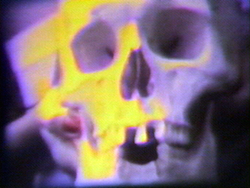|
EAI presents a seasonally themed free screening of macabre media that digs through the tropes of horror cinema. Although narrative, genre, and lurid popular entertainment may seem an unlikely source of inspiration for artists' media, the grotesque—and specifically its situation within the televisual dimension—has crept into approaches as varied as the diary video, direct-camera performance, film/video hybrid, and datamosh. By dissecting and reanimating the themes and scenarios of horror film and television, the artists offer a subversive post-mortem on the syntax and politics of the genre while offering a glimpse of the unknown, mysterious, and shocking that lurk at the video signal's outer limits.
Monster Voice, the first of several direct-camera performances by Cynthia Maughan included in the program, features the artist adopting a faux-ghastly tone of a grindhouse movie trailer announcer to describe a stereotypical woman-in-peril plot. In The Scary Movie, Peggy Ahwesh directs two young girls through a series of familiar horror film gestures set to a madcap audio assemblage of anarchic sounds and screams. Michael Smith's sitcom-style Secret Horror finds average guy ?Mike? ironing his pants in front of the TV before a gang of spooks arrive to whisk him away on a comic nightmare. Cecelia Condit plunges the viewer into a suburban nightmare in the uncompromisingly grisly yet eerily sing-songy Beneath the Skin, a tale of violence between partners that freely mixes processed film and video and found footage to invoke crossed identities and subterranean states. Takeshi Murata exhumes a scene from Mario Bava?s quintessential Italian gothic horror film Black Sunday to send star Barbara Steele reeling through a soupy digital mist. Catholic ritual, sexuality, and alienation course through Tony Oursler's vampire video Sucker. And George Kuchar's 1987 video diary The Creeping Crimson offers a closing meditation on the season and mortality; as he writes, "It is fall and Halloween, and mom is in the hospital. The leaves are red and the mood is blue, but life drips on."
PROGRAM
Cynthia Maughan, Monster Voice, 1975, 1:52 min
Peggy Ahwesh, The Scary Movie, 1993, 8:16 min
Michael Smith, Secret Horror, 1980, 13:38 min
Cynthia Maughan, Frozen and Buried Alive, 1975, 1:30 min
Takeshi Murata, Untitled (Silver), 2006, 10:37 min
Cecelia Condit, Beneath the Skin, 1981, 12:05 min
Cynthia Maughan, Suicide, 1974, 2:00 min
Tony Oursler, Sucker, 1987, 5:34 min
Cynthia Maughan, Coffin from Toothpicks, 1975, 1:54 min
George Kuchar, The Creeping Crimson, 1987, 12:50 min
Total running time: 70 min
___________________________________
About EAI
Founded in 1971, Electronic Arts Intermix (EAI) is a nonprofit arts organization that fosters the creation, exhibition, distribution, and preservation of moving image art. A New York-based international resource for media art and artists, EAI holds a major collection of over 3,500 new and historical media artworks, from groundbreaking early video by pioneering figures of the 1960s to new digital projects by today's emerging artists. EAI works closely with artists, museums, schools and other venues worldwide to preserve and provide access to this significant archive. EAI services also include viewing access, educational initiatives, extensive online resources, technical facilities, and public programs such as artists' talks, screenings, and multi-media performances. EAI's Online Catalogue is a comprehensive resource on the artists and works in the EAI collection, and features expansive materials on media art's histories and current practices: www.eai.org
___________________________________
Electronic Arts Intermix
535 West 22nd Street, 5th Floor
New York, NY 10011
t (212) 337-0680
f (212) 337-0679
info@eai.org
EAI on Facebook
EAI on Twitter
__________________________________

EAI's Public Programs are supported in part by the New York State Council on the Arts, with the support of Governor Andrew Cuomo and the New York State Legislature, and the New York City Department of Cultural Affairs, in partnership with the City Council. EAI also receives program support from the Andy Warhol Foundation for the Visual Arts.
|

